Environmental Engineering Reference
In-Depth Information
plate. The water below the 5-bar ceramic plate was
removed using an air pump when outflow from the soil
had ceased. The air pressure in the pressure chamber was
quickly released to zero and the reduction in the water
pressure in the high-suction tensiometer was recorded.
When the water pressure recorded on the high-suction
tensiometer ceased to change significantly, the applied air
pressure was increased to 300 kPa and the above procedure
was repeated. The same test procedure was repeated using
pressures of 400 and 500 kPa. The above procedure was
also used for tests on a reconstituted silt specimen.
Figure 4.20 shows the changes in measured water pres-
sures with time for the tests on Regina clay using the high-
suction tensiometer. When an air pressure of 200 kPa was
applied to the pressure chamber, the suction probe recorded
an almost instantaneous increase in water pressure from 0
to 195 kPa. The water pressure gradually reduced to about
25 kPa after 42 h.
Reducing the air pressure from 200 to 0 kPa caused the
water pressure to immediately fall from 25 kPa to a reading
of -158 kPa. The change in air pressure (i.e., -200 kPa) was
close to the change in water pressure [i.e.,
1 kg weight
Electrical tape
Aluminum foil
Soil specimen
Saskatchewan suction probe
Figure 4.21
Laboratory setup for measuring soil suction with
direct, high-suction range tensiometer (from Guan and Fredlund,
1997a).
Regina clay and reconstituted silt. Matric suction values
were applied to Regina clay and silt using a pressure plate
apparatus. The soil specimens were then placed onto the
high-suction tensiometer. The soil specimens were immedi-
ately covered with tin foil to prevent the loss of water from
the soil.
The results of matric suction measurements on Regina
clay placed in direct contact with the ceramic disk of
the high-suction tensiometer are shown in Fig. 4.22. The
preapplied matric suctions varied from 150 to 550 kPa.
The recorded curves are in reasonable agreement with the
preapplied matric suctions up to 450 kPa. The recorded
negative pressures for preapplied matric suctions of 500
and 550 kPa developed more slowly than those of the lower
suction specimens. It was noted that a crack appeared in
the soil specimen when matric suctions exceeded 450 kPa.
Figure 4.23 shows the results of measurements of matric
suction on the reconstituted silt specimens. There was a
−
(
25
+
158
)
=
−
183 kPa]. The water pressure measured by the suction probe
gradually increased because water slowly flowed into the soil.
When the water pressure reached -151 kPa, an increase
in air pressure to 300 kPa produced an immediate jump of
water pressure to about 145 kPa, an increase of 296 kPa.
Further tests also showed that a change in air pressure in the
pressure chamber immediately produced an approximately
equal change in water pressure in the high-suction tensiome-
ter. The difference between the change in the air pressure
inside the pressure chamber and the change in water pres-
sure in the suction probe was generally less than 5%. The
Regina clay remained saturated throughout the test.
4.2.6.5 Measurement of Preapplied Matric Suction
Figure 4.21 shows the laboratory setup that was used to
measure the matric suction on reconstituted specimens of
300
u
a
= 200 kPa
u
a
= 400 kPa
u
a
= 300 kPa
u
a
= 500 kPa
200
100
0
−
100
u
a
= 0 kPa
−
200
u
a
= 0 kPa
−
300
u
a
= 0 kPa
−
400
u
a
= 0 kPa
−
500
0
2000
4000
6000
8000
10,000
12,000
14,000
Elapsed time, min
Figure 4.20
Verification of high-suction measurements on Regina clay using University of
Saskatchewan direct high-suction range tensiometer (from Guan and Fredlund, 1997).










































Search WWH ::

Custom Search